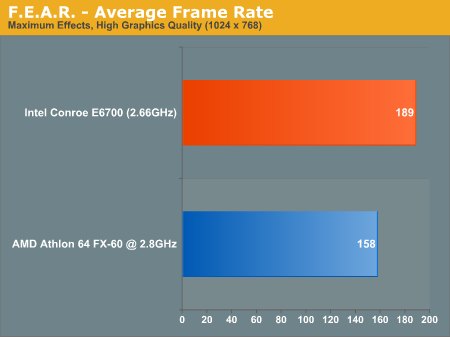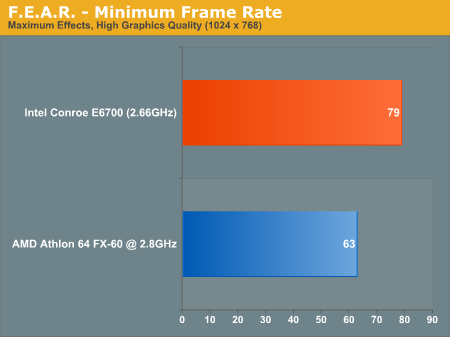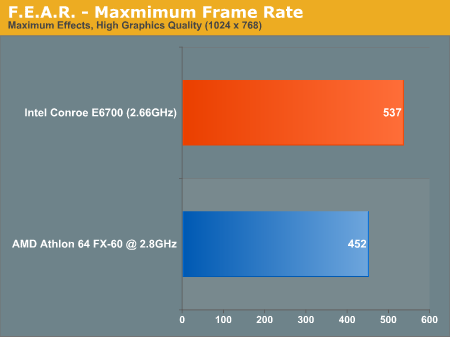Conroe Performance Preview Follow-Up
by Anand Lal Shimpi on March 9, 2006 9:30 AM EST- Posted in
- Trade Shows
The F.E.A.R. Issue
To the readers that pointed out our F.E.A.R. results as being unusually high, we owe you a sincere apology. When we went back to test Conroe for the second time we re-ran all of our tests to make sure that no mistakes were made. We caught the Quake 4 issue where Conroe’s SMP performance was understated, and we also discovered a problem in our F.E.A.R. testing.
While our intention was to test both the AMD and Intel systems at the “Maximum” Computer settings and “High” Graphics settings, only the Conroe system was configured as such. We inadvertently left the AMD system at a higher resolution (1280 x 960) instead of the default resolution (1024 x 768) when you select the “High” Graphics defaults. The oversight was entirely our own doing as Intel was not running the benchmarks or configuring them, it simply happened while we were setting up both systems at the same time. We played with different resolution settings and while deciding that we would go with one, managed to configure the two boxes differently.
Of course this means that our initial F.E.A.R. tests were incorrect, and below we have the correct results with the settings we intended to run both systems on:

The performance advantage of Conroe makes a lot more sense now, at 20% instead of 41%. With performance in Quake 4, UT2004 and HL2 in the 20 - 30% faster range on Conroe, the F.E.A.R. results now make a lot more sense.


To those who pointed out that even the CrossFire X1900 setup would be more GPU bound at 1280 x 960, you were very correct, our original results were inaccurate. We do strive for accuracy and reliability in our results here at AnandTech, which is why we went back and retested/confirmed all of our initial findings before bringing you this update. Aside from the F.E.A.R. and Quake 4 issues that we've since corrected, we found no other performance anomalies in our initial results.










96 Comments
View All Comments
fitten - Thursday, March 9, 2006 - link
Right conclusion, wrong cause. What really "halves the cache" is pointers (which have to be 64-bit now instead of 32-bit). Programs that use few pointers will show little difference in cache usage. Programs that use lots of pointers (read: written in Java, C#, and those type languages) will show increase cache usage from all the larger pointers. 64-bit and 64-bit instruction set does not imply that the instructions are actually 64-bits long, in fact, it rarely implies that (64-bit RISC processors, for example, tend to have all/mostly/many 32-bit instructions, just like their 32-bit processor counterparts, for example).Nighteye2 - Thursday, March 9, 2006 - link
I'm not saying it halves the cache. Just that the instructions are longer, not necessarily 64 bits long. I expect the difference to be more like a quarter, rather than half, if I'd have to make a guess at it.AlexWade - Thursday, March 9, 2006 - link
AMD forced Intel to make a first-rate CPU. And the good news is we win. I knew Intel couldn't stay down forever. Neither will AMD. I think it still bothers Intel, however, that they have to use AMD's 64-bit code.Am I reading this correctly that Conroe is a single-core CPU? I would like to know more about dual-core CPU's, that is the future.
fitten - Thursday, March 9, 2006 - link
From what I've heard in the rumor mill (nothing that anyone else can't hear), there will be no single-core Conroe chips. I'm sure marketing pressure might lead to them, though. The test system definitely had a dual-core Conroe, though.Von Matrices - Thursday, March 9, 2006 - link
No single core Celeron Conroes?pnyffeler - Thursday, March 9, 2006 - link
I have to agree. I've been building AMD rigs for many years and have always pulled for the underdog, but I have to tip my hat to the Intel man on this one. They have raised the bar after getting smacked in the forehead with it for too long.Intel had become pretty lazy over the past few years, and I think it took way too long to realize that they were peddling 2nd rate products that wasted enough heat to qualify as a space heater.
AMD also has done well in this, too. By building a no-question better product, they were able to steal a good chunk of the market share, and their momentum right now will be hard to beat. Now I'm waiting for AMD's counter punch, and from what I've seen so far, if they think it's the AM2 with DDR2, they're gonna get steam-rolled.
cscpianoman - Thursday, March 9, 2006 - link
This is Intel!Sorry, had to be an ostrich fan-boy for the moment. I think it interesting that Intel really upped the ante on this one. They didn't want to match AMD's next stuff, they wanted to clobber it. Unless AMD pulls a rabbit out of their hat, I see Intel holding onto this performance crown. I'm interested to see what AMD has to counter this.
psychobriggsy - Thursday, March 9, 2006 - link
Even I, as an AMD supporter, hope that this will shut up the extremist ostrich-like fanboys on the AMD side who can't see that Intel has finally done well.It will be interesting to see a comparison between Conroe at $x and a Pentium D at $x when they're released too.
And well done for admitting a fault with the FEAR test.
mongster - Friday, March 10, 2006 - link
Agree with you. Been an Intel supporter for many years and when it was time to upgrade my flailing Willamette system, I decided to wait for Prescott, thinking that I don't want to jump onto the AMD bandwagon. When AMD trounced Intel Prescott, I decided to wait for dual core. But when AnandTech and other sites put out convincing data on why AMD continues to be the better buy for CPU's, I decided it was high time to switch over to the other camp. That was what I did last year when I finally assembled my first AMD system (have assembled AMD systems for my friends but never for myself). Now, I am thinking, should I have waited? Conroe's numbers sure are impressive but I will wait for the architecture to mature first (and the prices to stabilize haha) and see if AMD has anything up their sleeves to counter Conroe.Just my 2 cents.
Calin - Monday, March 13, 2006 - link
Yes, if your old computer's performance was enough, you should have waited another 6 or more months for Conroe. If you were concerned about price, maybe you should have waited until early next year.When you choose to upgrade, Intel wasn't the clear cut best option, like it seems to become in half a year